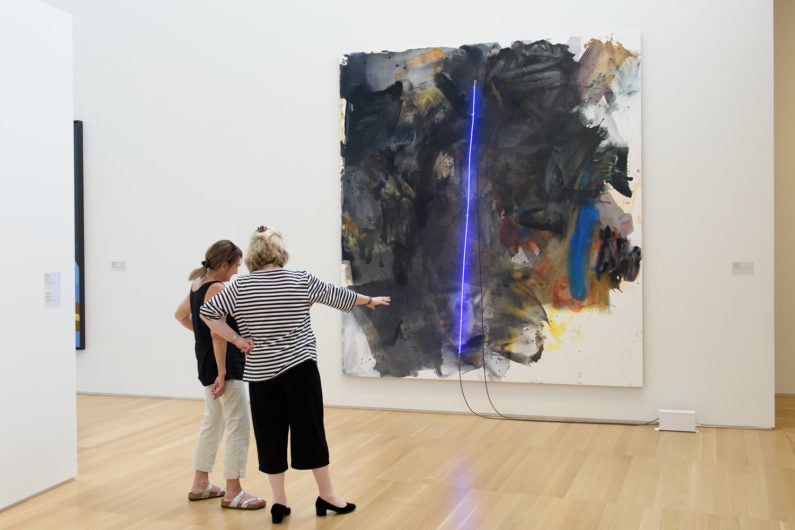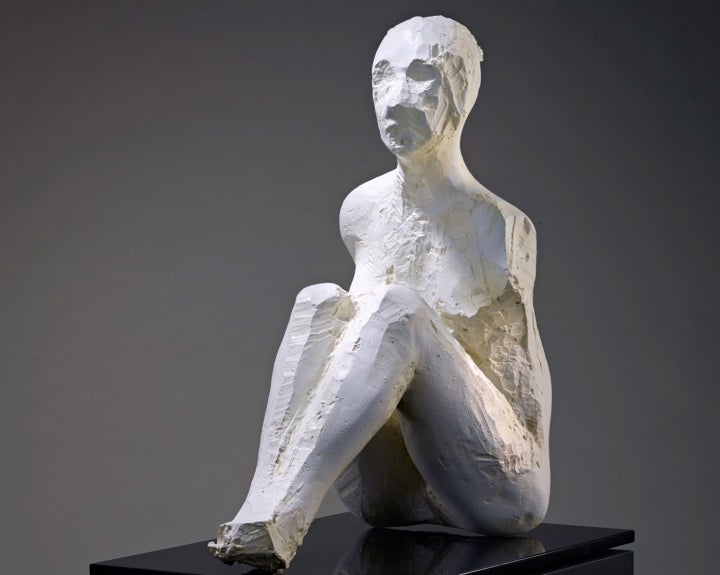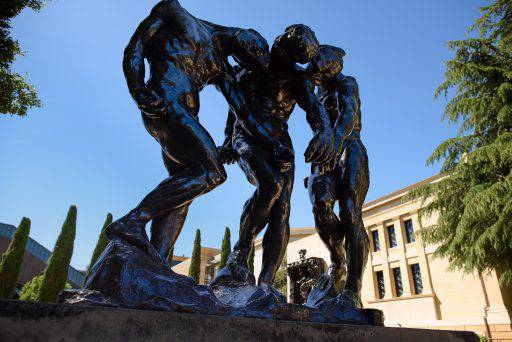Take an art break at the Stanford museums
The Anderson Collection and the Cantor Arts Center are open during the winter break except on Christmas Day, with special holiday hours on Christmas Eve and New Year’s Eve only.
There are things to see and hear, inside and outside, at the Stanford art museums during the holiday season. While the rest of the campus is closed from Dec. 23 through Jan. 7, the Anderson Collection and the Cantor Arts Center welcome visitors to enjoy both wide-ranging temporary exhibitions and the museums’ stellar permanent collections.

Anderson Collection patrons Christine Nicholas and Julia Procopé stop to discuss Mary Weatherford’s black painting, a gift of Debra and Steven Wisch in honor of the Anderson family. (Image credit: L.A. Cicero)
Holiday hours at both museums include early closures at 3 p.m. on Christmas Eve, Dec. 24, and New Year’s Eve, Dec. 31. The museums are closed on Christmas, Dec. 25, but open regular hours, 11 a.m.-5 p.m., on New Year’s Day, Jan. 1.
Parking permit enforcement in A and C lots, as well as visitor and metered spaces, will be suspended during winter break, effective Dec. 23–Jan. 7. Exceptions to the suspension are parking facilities serving the hospitals and the School of Medicine, including the Roth Way Garage.
This year, the Anderson Collection at Stanford University, the museum of postwar modern and contemporary American art, announced its first gifts since opening in September 2014. The gifts include black painting by Mary Weatherford, on view in the second-floor galleries, and gifts from The Manual Neri Trust that comprise special exhibition Manuel Neri: Assertion of the Figure in the Wisch Family gallery on the first floor through Feb. 12, 2018.

On view at the Anderson Collection is Manuel Neri’s Joan Brown Seated, a gift of the Manuel Neri Trust. (Image credit: M. Lee Fatherree)
Neri, a California native, renders his work in several mediums that include plaster, marble, bronze and paper – all of which are represented in the exhibition, providing a glimpse into the artist’s creative process.
Complementing the indoor exhibition of Neri’s work are seven of his outdoor sculptures on loan to the Anderson Collection from Hackett Mill gallery in San Francisco that reference the artist’s origins with plaster and his expressionistic manipulation of the medium. The outdoor installation is located on the grounds of the museum and is also on view through Feb. 12.
On Thursday, Dec. 28, the film Louise Bourgeois: The Spider, the Mistress and the Tangerine screens at 6 p.m. in the Denning Family Resource Center at the Anderson Collection. The museum is open until 8 p.m. on Thursdays and the screening is free and open to the public.
Cantor exhibitions
There are six special exhibitions on view at the Cantor Arts Center during winter break.
The playful and perceptive exhibition Nina Katchadourian: Curiouser explores several major bodies of work by Katchadourian, including video, photography, sculpture and sound installations. Using ingenuity and humor, the artist encourages us to reinvigorate our own sense of curiosity and to see our everyday surroundings as sites of discovery and possibility. The exhibition is on view through Jan. 7, 2018.
In the oak tree grove in front of the Anderson Collection, among the Neri sculptures, is an extension of Curiouser titled Please, Please, Pleased to Meet’cha. The outdoor audio installation investigates the difficulty in translating the elusive sounds created by birds. In sound systems installed in the trees, visitors hear audio recordings of United Nations translators attempting to vocalize the sounds of six different birds, without having previous familiarity with the bird and only relying on materials found in birding guidebooks. This part of the Curiouser exhibition is also on view through Jan. 7.
Marking the centenary of the Russian Revolution of 1917, The Crown under the Hammer: Russia, Romanovs, Revolution examines the political, social and cultural upheavals that transformed Russia in the final decades of the Romanov dynasty and the first years of Soviet Communism. Jointly organized by the Hoover Institution Library & Archives and the Cantor, this dual-site exhibition features a wide variety of art objects and documentary material. Paintings and posters, photographs and films, rare books and decorative art objects alternately evoke the lost world of Russia’s old regime and hint at the utopian future imagined by the nation’s revolutionaries. The Hoover Exhibit Pavilion is closed during winter break, but the Cantor portion of the exhibition is open and on view through March 4, 2018.
In conjunction with The Crown under the Hammer exhibition, Montage Fever is screening at the Cantor through Jan. 21, 2018. Montage Fever concerns the centrality of the process of montage, or editing, in the cinema – a topic of utmost importance to many Soviet filmmakers of the revolutionary era. Made a century after the October Revolution, Montage Fever consists of scenes and sequences from a variety of Soviet films.

The Rodin Sculpture Garden is open to visitors 365 days a year, but tends to see a spike in visitors during the holidays. (Image credit: L.A. Cicero)
Artist Hope Gangloff, the Cantor’s first Diekman Contemporary Commissions Program artist, was in residence at the museum earlier in 2017. An installation of her paintings, including a portrait painted on site of staff member Tammy Fortin that is now part of the Cantor’s permanent collection, is on view in the museum’s historic atrium through Feb. 12, 2018.
About Face: Intimacy and Abstraction in Photographic Portraits considers the voyeuristic intimacy of the close-up portrait in 13 photographs by celebrated photographers Ansel Adams, Imogen Cunningham, John Gutmann, Barbara Morgan and Edward Weston. Dating from the 1920s to the early 1940s, each striking photograph captures a likeness and the mood set by the subject’s personality. Taken in close proximity or cropped in the darkroom, the images present their subjects in great detail but also allow passages of abstraction to emerge from the clean geometry of the compositions. The exhibition is on view through March 4, 2018.
The Buddha’s Word @ Stanford, on view through March 18, 2018, showcases Buddhist manuscripts and prints held at the Cantor and in Stanford libraries. Twenty-two works dating from the 11th century to the early 20th century represent various parts of the traditional Buddhist world from Sri Lanka to Japan. The exhibition highlights the written word not simply as the visual counterpart to speech but as a thing of beauty and sacredness by itself.
Also on view through March 18 is Earthly Hollows: Cave and Kiln Transformations, which presents a focused look at caves and kilns, aka “earthly hollows,” as symbolic and physical passages of transformation. Drawing from Cantor’s rich collection of Chinese, Japanese and Korean art,the small exhibition of 10 works examines the dynamic ways in which tunnel-like chambers made of earth and clay, be they mountain grottoes or kilns, connect the mundane and the mystical realms.
In addition to the Cantor’s special temporary exhibitions, the permanent collection galleries are not to be missed. Object Lessons: Art & its Histories presents the most significant reinstallation of the museum’s permanent galleries in 20 years, and Rodin: The Shock of the Modern Body spans three galleries and features nearly 100 Rodin sculptures drawn from the Cantor’s extensive holdings, the largest collection of sculptures by Rodin in an American museum.
Outside of the museums there are dozens of outdoor works of art that are viewable 365 days a year. Works by Ellsworth Kelly, Joan Miro, Auguste Rodin and Andy Goldsworthy are located on the museums’ grounds or are a stone’s throw away. Further afield is the Papua New Guinea Sculpture Garden located on the southwest side of campus, Peter Wegner’s suite of five site-specific pieces at the Graduate School of Business and many more located in-between.
